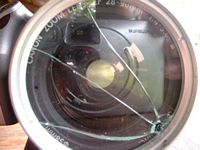MY CAMERAS
For a long time photography for me was all about holidays and I could not imagine going on any holiday without a good camera to capture those magic, and not so magic, moments.
My first real trip abroad was back in 1985 and for that I had only a cheap 110 cartridge film camera and was continually frustrated by its limitations. So for my next trip I went out and bought an 35mm SLR. I got a Pentax P30 which had just come to the market and had very good reviews. It came with a 28-80 lens and later on I purchased a 70-200mm lens to compliment it. It was a great camera to use.
In 2003 I went on a trip of a lifetime which lasted fourteen months and took me across Europe and Asia to Australia and New Zealand. As it was such a significant adventure I decided to retire my faithful Pentax P30 SLR, a veteran of some seventeen years, in favour of a new model from the popular Canon EOS range - the EOS 300V with a Tamron 28-300mm lens. Unfortunately this modern camera did not travel well and when it went for an unfortunate encounter with water I had lots of problems trying to get it repaired. The Canon Service Centres in Phnon Penh, Bangkok and Kuala Lumpur all said they could fix it but did not have the part needed. In Australia I was eventually told it was not economical to repair. I got a new replacement but the flash on this went within the year. I was not impressed with my Canon purchase and it is unlikely I would buy a Canon again.
For that trip I also purchased a basic digital camera, a Fuji A201, so I could let people back home see my travel experiences without having to wait for the hefty photo albums when I returned. I must admit that I have been very impressed with the photographs taken with it and although only used on a basic mode I have run a few 6x4 prints off which look really great. The instant feedback from this type of camera has also, I believe, helped me with my photography. The camera was very robust and unlike the Canon survived the water encounter. After drying out it worked fine and still works wonderfully today ... well done Fuji.
In January 2008 I bought my second digital camera as the technology had moved on so much. I purchased a Nikon Coolpix L5 which has a five times optical zoom. It doesn't get out to 28mm wide angle unfortunately but it was difficult to get a camera which fitted in with all my needs. I would have happily bought Fuji again but I wanted a camera which used the popular SD card format.
TIPS
I would recommend anyone considering their travel photography needs to think about having a wide angel capability (28mm) for those majestic landscapes and interiors. And being able to zoom in (at least 200mm) is an
invaluable benefit for wildlife photography and for the opportunity for those more candid shots. If you have an SLR having these both in one lens is a huge benefit in not messing around changing lenses, which was my previous situation, and less weight to carry around.
 For anyone with an SLR I would recommend two filters. A basic skylight, or UV filter, mainly to protect your valuable lens from scratches and other potential damage. It is easier, and far cheaper to replace the filter than a lens. I can vouch for this myself as having had the camera fall from my hands the filter took the impact and the lens was undamaged. The other is a polariser which will enhance your pictures on sunny days by reducing glare and bring out the colours. To a large extent the advent of digital photography and the availability of good photo editing software has negated the need for other filters.
For anyone with an SLR I would recommend two filters. A basic skylight, or UV filter, mainly to protect your valuable lens from scratches and other potential damage. It is easier, and far cheaper to replace the filter than a lens. I can vouch for this myself as having had the camera fall from my hands the filter took the impact and the lens was undamaged. The other is a polariser which will enhance your pictures on sunny days by reducing glare and bring out the colours. To a large extent the advent of digital photography and the availability of good photo editing software has negated the need for other filters.
 For anyone with an SLR I would recommend two filters. A basic skylight, or UV filter, mainly to protect your valuable lens from scratches and other potential damage. It is easier, and far cheaper to replace the filter than a lens. I can vouch for this myself as having had the camera fall from my hands the filter took the impact and the lens was undamaged. The other is a polariser which will enhance your pictures on sunny days by reducing glare and bring out the colours. To a large extent the advent of digital photography and the availability of good photo editing software has negated the need for other filters.
For anyone with an SLR I would recommend two filters. A basic skylight, or UV filter, mainly to protect your valuable lens from scratches and other potential damage. It is easier, and far cheaper to replace the filter than a lens. I can vouch for this myself as having had the camera fall from my hands the filter took the impact and the lens was undamaged. The other is a polariser which will enhance your pictures on sunny days by reducing glare and bring out the colours. To a large extent the advent of digital photography and the availability of good photo editing software has negated the need for other filters.